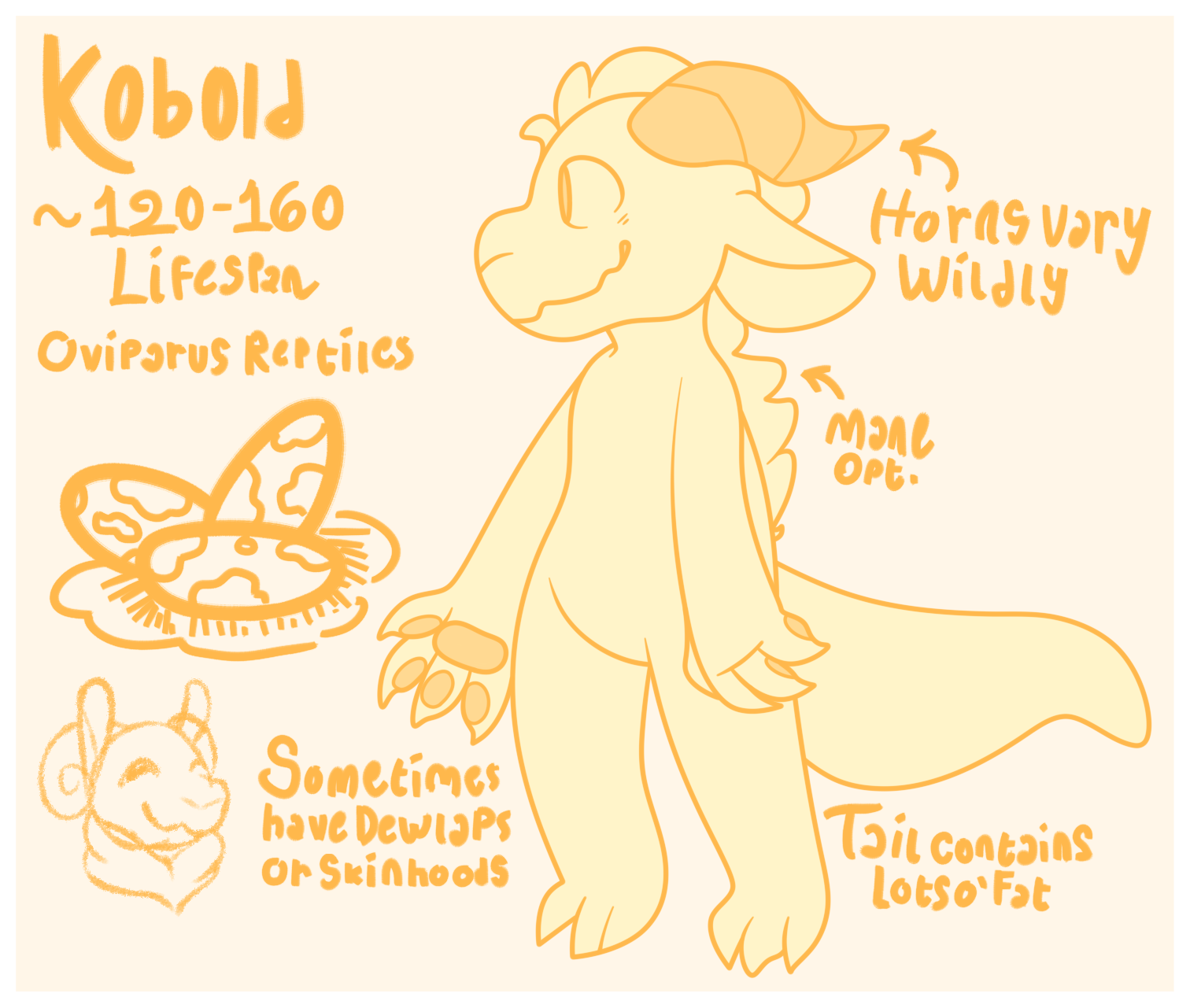Kobold (Ko·bold)
Kobolds are rather odd yet welcoming and friendly people. They are highly tight knit, their entire community and friends are family. A whole warren of Kobolds will help each other raise their children, and even help each other raise money to send their children to get educations.
Kobolds also, famously, deeply care about Dragons. Historically they have worshipped them, but most nowadays have shifted to seeing them as a part of their close family. Some may still worship them, but it's not as wide-spread.
Kobolds also, famously, deeply care about Dragons. Historically they have worshipped them, but most nowadays have shifted to seeing them as a part of their close family. Some may still worship them, but it's not as wide-spread.
Basic Information
Anatomy
Kobolds are bipedal tetrapod reptiles. Kobolds have varying horns, occasionally finding themselves with two or more sets, pawpads on their hands, and big tails that contain extra fat. These tails can, depending on the Kobold, sometimes be dropped and regrown.
Kobolds have two other traits that aren't guaranteed: Manes and Dewlaps/Skin Hoods. Their manes run down their back, sometimes even reaching their tail, and are soft like the fur on a cat. Their dewlaps take many forms, get creative!
Sometimes you might see a Kobold with a horizontal pupil, due to their prey animal heritage! This isn't a given for every Kobold, many have the slit pupils they evolved later on, but it's rather stubborn in not wanting to go away.
Kobolds have two other traits that aren't guaranteed: Manes and Dewlaps/Skin Hoods. Their manes run down their back, sometimes even reaching their tail, and are soft like the fur on a cat. Their dewlaps take many forms, get creative!
Sometimes you might see a Kobold with a horizontal pupil, due to their prey animal heritage! This isn't a given for every Kobold, many have the slit pupils they evolved later on, but it's rather stubborn in not wanting to go away.
Genetics and Reproduction
Kobolds will gestate a clutch for two months before laying them. Clutches typically contain one-to-three spotty eggs, which will sit for five weeks until they hatch. These eggs must be kept warm and attended to very carefully.
Growth Rate & Stages
Kobolds are born absolutely miniscule, about the size of a kittens, and grow fast. While they are able to take care of themselves at very young ages due to being prey animals, they continue growing until they turn 16. Kobolds may be allowed move out at this age, however they are only considered mental/societal adults at 21.
Dietary Needs and Habits
Despite their draconic appearance, Kobolds are actually omnivores (leaning on the vegetarian side of things)
This is due to evolving from prey animals.
This is due to evolving from prey animals.
Biological Cycle
Kobolds shed their skin once about every month or two, which tends to make them get all itchy and icky. Eugh.
Additional Information
Perception and Sensory Capabilities
Kobolds, aside from typical sensory capabilities, have a heightened dark vision. They are able to see far in the dark, but this comes to bite them in giving them sensitivity to direct sunlight.
Civilization and Culture
Naming Traditions
Kobolds are named after words in Koboldian Draconic. What suffices for a suitable Kobold name may sound like naming your child "Cloud" to a dragon.
Kobold packs will all share a last name, they are very important as it shows their pack will always love and appreciate them.
Kobold Names: Staullvarht, Minnov, Kleaur, Velkan
Kobold packs will all share a last name, they are very important as it shows their pack will always love and appreciate them.
Kobold Names: Staullvarht, Minnov, Kleaur, Velkan
Major Language Groups and Dialects
Kobolds speak Draconic, specifically the Koboldian dialect. Koboldian Draconic is the only version of the language that non-dragons can actually speak, due to requiring roars and growls that a species like an elf cannot produce.
Scientific Name
Eublepharidae Draco
Lifespan
~120-160 Years
Average Height
~2-3 Feet (or ~60.9-91.4 CM)
Average Weight
~26-34 lbs (or ~11.7-15.4 kg)
Body Tint, Colouring and Marking
Every color, marking, and tint under the sun! Some may even show chameleon-like color changing.



